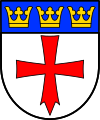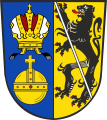Crown (heraldry)
The crown is a common figure in heraldry not only in the coat of arms , but also in the upper coat of arms .
Use and design
The type of crown in the coat of arms is specified in the coat of arms description . Which crown shape is chosen depends on the social position of the bearer of the coat of arms and is shown with the chosen crown . It enhances the coat of arms. For the simple representation (crown without rank symbolism), however, the three-pronged crown with clover-leaf or lily-shaped crown prongs above the crown circlet has become widespread, if not expressly deviated from. The color of the chosen crown is preferably emblazoned, as well as the details (zigzag shape and number, precious stones), as far as the size of the coat of arms allows it and it is necessary, or more special shapes such as bow crown , serrated crown and the like.
The crown can float in the shield as its own heraldic figure , but especially as a decorative attribute of a heraldic animal or a human figure or other common figures such as cross and column (blazon: crowned ), or laid on (a crown on top) . Occasionally, the crown is also drawn heraldic animals over the neck as the swan can occur, for example (neck crowned) . Also imposed is common in the cross. This also applies to crowns above the shield. In the case of crowned heraldic animals, there may be a color conflict if, for example, a halo surrounds the head, a swan (naturally silver) is crowned with gold, or the color of the coat of arms (the background) is the same as the color of the crown: Smaller attributes do not have to strictly follow the color rule.
Many coats of arms have a crown placed on the upper edge of the shield , or it hovers over the shield. The crown used usually corresponds to the long history of the coat of arms, but it can also be just the simple crown of rank. Often a crown is placed on the heraldic helmet and is then specifically called the helmet crown . The two representations are actually synonymous, as the helmet is only presented in the full coat of arms, but the crown of rank should be retained if the upper coat of arms is omitted. Territorial coats of arms in particular often only have a crown on the shield, otherwise this representation also forms the small coat of arms .
Variants of the crown
In principle, the heraldic crowns also include the whole hats ( ducal hat and the like) as well as the miter (bishop's cap ) , also called inful , a Latin term that, like the Greek miter (head band), has been used to designate the bishop's cap since the high Middle Ages . Like the crown, they are mostly only used in the upper coat of arms. The tiara is a special form - it is only used in papal coats of arms.
In the upper coat of arms, the wall crown represents a special form of coat of arms decoration. It is a republican symbol and can usually be found on the coat of arms of the cities. While the people's crown was introduced in Germany after the end of the monarchy , the Austrian eagle is adorned with a wall crown.
In addition, there are numerous special crowns, namely the imperial crown , the Rudolf crown of the Habsburgs and the Saint Stephen's crown of Hungary or the Lombard iron crown (Lombardy): They have a very specific appearance that is also adhered to in heraldry.
Coats of arms with three crowns in the shield are called three-crown coats of arms .
Examples
four-pointed wall crown ( Bad Homburg vor der Höhe )
a crown in confused colors in the base of the shield ( Bad Neuenahr-Ahrweiler )
oysters floating in the upper field ( Baustert )
with ermine cuff ( Epfendorf )
Three crowns in the shield head ( Gondorf )
Wall and camp crown ( Kronach )
Crown, on it plume as a helmet ornament ( Kronberg im Taunus )
Floating imperial crown above the Reichsapfel ( Lichtenfels district )
Wall crown ( Tempelhof-Schöneberg district of Berlin )
Crown of rank ( Canary Islands )
Stylized crown on the coat of arms ( Croatia )
Crowned double-headed eagle with floating imperial crown ( Russia )
Crown over shield and heraldic tent ( Serbia )
Crown over the shield ( Stephanskrone ) and drawn over a cross ( Hungary )
See also
literature
- Walter Leonhard : The great book of heraldic art. Development, elements, motifs, design. 2nd, revised and expanded edition. Callwey, Munich 1978, ISBN 3-7667-0345-5 .













